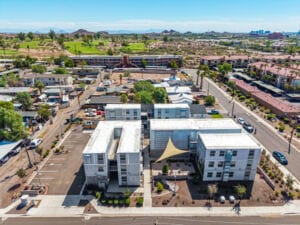It’s not uncommon for residents and visitors of Arizona alike to lament the often treacherous triple-digit temperatures of the summer months. But, for construction and trade workers whose livelihood depends on working outdoors, outcomes attached to seasonal heat and the elements present significant dangers. In addition to heat-related illnesses and serious health issues, thunderstorms and monsoons deliver added risk of injury.
READ ALSO: Here are the biggest projects of Ryan Companies’ 25 years in Arizona
According to the CDC, 285 construction workers died from heat-related causes between 1992 and 2016, and 75% of these deaths happened in June, July, and August. And from 2006 through 2021, the CDC reported lightning strikes caused an average of 28 deaths per year in the U.S. Additionally, a report published by the Union of Concerned Scientists, “Too Hot to Work,” revealed that historically, Maricopa County experiences 13 at-risk workdays due to extreme heat for outdoor workers.
To help mitigate summer-related dangers for construction workers, it’s crucial to have temperature- and weather-focused safety parameters in place.

Heat halt
“Safer projects make for happier workers,” says Toni DiDomenico, regional safety director for Ryan Companies. “And happier workers are more productive workers.”
In an effort to keep their outdoor workers safe from the elements, Ryan Companies has implemented several summer-specific safety strategies and procedures.
In some instances, something as simple — but easily overlooked — as heat preparedness is important, according to DiDomenico. “We incorporate ‘best practices’ to ensure our workers and subcontractors are prepared for the heat when the summer months arrive,” she says, “In some instances, workers enjoying their weekends may not always be preparing themselves to hydrate prior to Monday morning. When they arrive at work, they could become dehydrated because of this.”
In terms of onsite protocols, Ryan provides “cooling areas.”
“A small trailer will be set up on the project site in a safe and strategic location with power provided to it,” DiDomenico says, “to offer an area with cooler temperatures for workers who are experiencing heat stress conditions to enter and sit, recuperate and hydrate.”
The trailers are equipped with air conditioning, beverages with electrolytes and water additives, and are fitted with outside canopies to provide a space for shade and rest.
What about instances — as in the case of “at-risk workdays due to extreme heat” — is a job at risk of being shut down?
“It is very rare that a project will be shut down due to heat,” DiDomenico explains. “I have seen one job shut down years ago but the temperatures on the roof were greater than 160 degrees.”
The reason for work seldom stopping makes sense when considering that, as noted by the “Too Hot to Work” study, “The loss of safe workdays places $641,584,709 in outdoor workers’ earnings at risk annually across the country. That represents 5% of total outdoor worker earnings.”
Adds DiDomenico “With the best practices of providing water, rest and shade there are fewer and fewer impacts. We are a proponent of starting our days earlier to finish earlier, so our workers can be out of the sun when peak temperatures arrive. Ryan also encourages regular water and rest breaks to ensure our team members are staying hydrated throughout the day.”

Storm watchers
As for storms and monsoons, as with high temps, preparedness goes a long way in securing outdoor-worker safety. Ryan utilizes a weather tracking and communication system.
“Field management all have weather apps that provide multiple alerts of possible lightning strikes and wind speeds,” DiDomenico says. “When lightning is within ten miles of a project, all workers are removed from scaffolding to ensure their safety. And as winds begin to intensify, we work with crane operators to determine when the apparatus needs to be suspended.”
Additionally, if the threat of storms and monsoons are imminent, Ryan ensures all materials on the job are secured.
Air care
But, while heat and monsoons introduce their own set of dangers, that’s not all outdoor workers must contend with during the Valley’s summer months.
“Another commonly overlooked health hazard is air quality, when smoke from nearby forest fires could impact one of our project sites,” DiDomenico says. “Ryan establishes thresholds for air quality, and we will shut down a job for the day if the air quality worsens to protect our workers and subcontractors.”
For an added summer-safety precaution, DiDomenico explains that the OSHA-NIOSH Heat Safety tool has been a helpful tool in assessing worker health and safety. “[It’s an] app that iPhone and Android users can download for free on their mobile devices,” she says. “The app allows workers to calculate the heat index for their worksite, shows a risk level for working outdoors and provides reminders of protective measures that should be utilized to prevent heat-related illness.”




